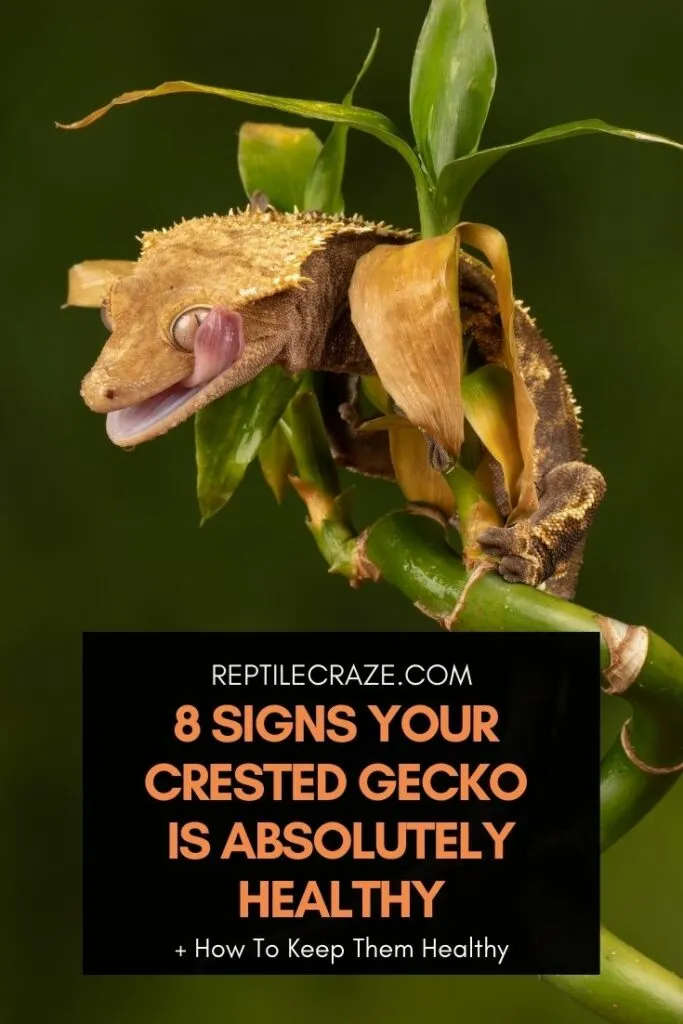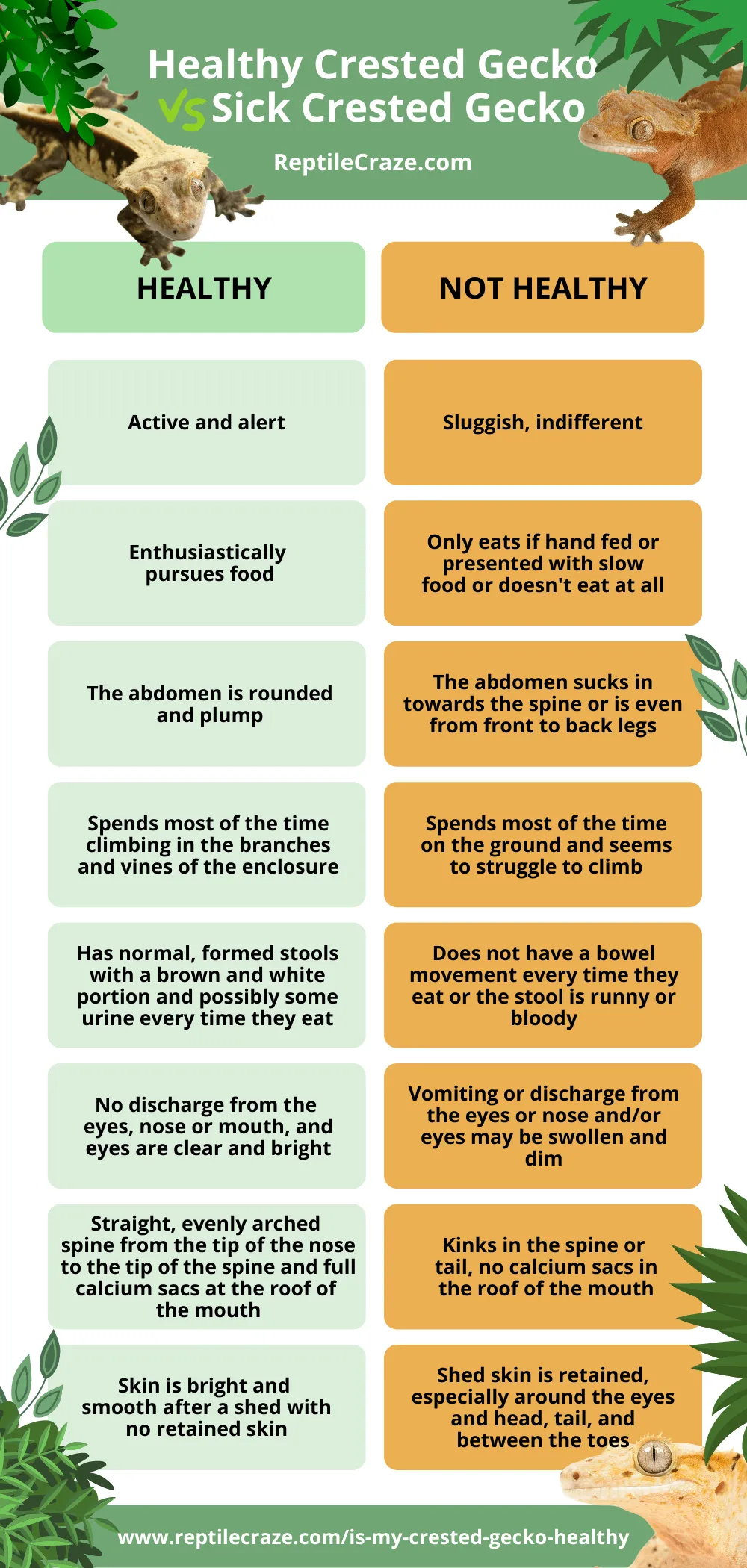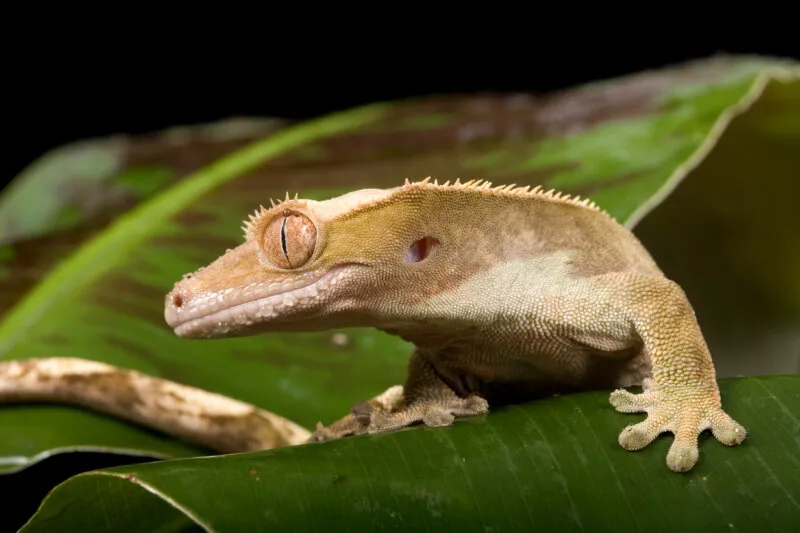
Crested geckos are some of the most popular reptilian pets available, thanks to their adaptability to captivity, their striking appearance, and their docile nature. However, even a gecko that adapts well to captivity, like the crested gecko, can have health issues. Naturally, you’ll want to carefully observe your crested gecko to be sure that it is healthy.
You’ll know that your crested gecko is healthy if it is active and alert, eats readily and with enthusiasm, has a good weight, spends most of the time climbing, has normal, regular stools, doesn’t have discharge from the eyes, nose, or mouth, and has bright, smooth skin after a shed.
Here are some more details to help you determine whether your crested gecko is healthy, as well as some tips for great crested gecko husbandry.
Table of Contents
Signs That Your Crested Gecko Is Healthy
In the infographic below, we show you what a healthy crested gecko looks like vs. what an unhealthy crested gecko looks like. After that, we explain everything in detail and what you should look out for.
At the end of the article, we show you things you should do in order to keep your crested gecko healthy.
So, let’s get right into it!

1. Your Crested Gecko is Active and Alert
It is perfectly normal for crested geckos to go through periods of activity alternating with periods of a calm, relaxed state. Do not expect your crested gecko to be continuously active.
However, a healthy crested gecko will typically be more active in the early morning and late evening and throughout the night. When your crested gecko is resting, it should be alert and attentive.
Sudden movements near the cage or reaching into the cage should prompt a response. If your crested gecko appears sluggish or indifferent to what’s going on in its environment, it could be a sign of poor health.
2. Your Gecko Eats Enthusiastically
The average crested gecko is excited about its
When geckos find fruit or nectar, they should happily lap it up. If your crested gecko is turning up its nose at
Keep in mind that crested geckos don’t eat when they are shedding, so if your crested gecko is refusing food when its skin is loose and white and a shed is near, don’t worry.
However, your crested gecko should begin eating again a few days after it has finished shedding at a minimum.
A crested gecko that continues to go without eating for some time after shedding may be having an issue.
3. Your Crestie Maintains Good Weight
A healthy crested gecko shouldn’t be fat, but it should be pleasantly plump. The abdomen should round out evenly on both sides when viewed from above.
If the abdomen sucks in towards the spine or remains even from the front to the back leg, your crested gecko is likely underweight.
On the other hand, if the stomach balloons out and drags along the ground when your crested gecko is in movement, it may be overweight.
It is very common for crested geckos to gain too much weight. This probably is not a sign of poor health, but rather of poor husbandry. If your crested gecko is too fat, slowly reduce
If, on the other hand, your crested gecko is too thin, carefully observe how much it’s eating. If your gecko isn’t gaining weight by eating what should be a healthy diet, a trip to the vet may be in order, as it may have a metabolic disorder or parasites.
If you are concerned that your gecko isn’t gaining weight appropriately, you can easily track weight like this gecko owner does:
4. Your Gecko Climbs Most of the Time
Healthy crested geckos are superb climbers. The average crested gecko prefers climbing vertical surfaces to staying on the ground. Most of the time, you can expect to see your crested gecko up in the vines and branches of its enclosure.
Most only descend to the ground to eat or drink before ascending again. Your crested gecko should not have any trouble climbing the vines and branches in its enclosure. They use their strong fingers and toes and their prehensile tail to assist them in climbing.
If you notice that your crested gecko is spending most of its time on the ground or that it is struggling to climb, it can be a sign of weakness and poor health. Be sure that there are plenty of vines and plants of varying widths so that your crested gecko has options in how to climb.
5. Your Gecko has Normal, Regular Stools Every Time it Eats
While it may not be the most appealing part of crested gecko husbandry, monitoring your crested gecko’s elimination habits is very important. A healthy crested gecko poops as often as it eats.
That means that after you feed your crested gecko, you should see a stool at a regular interval afterward. Different geckos go different lengths of time, but you should not be seeing your gecko eat several times before a stool.
For adults, this means that they will typically have a stool three or four times a week, while young crested geckos may have a stool four to seven times a week.
Like most reptiles and birds, crested geckos have only one kind of elimination that includes both stool and urine. Everything comes out of the same cloaca.
Normal stool should be part a shade of brown from light to dark and part chalky urate. There may or may not be a little bit of clear pee. Pee isn’t always visible, so don’t be too concerned if you only notice the brown and white portion.
Depending on how big and old your crested gecko is, the dropping can range from the size of a grain of rice to about the size of a quarter.
A strong smell is normal, especially while it’s fresh. Abnormal stool may be very runny or not have a clear separation between the brown part and the white part. Blood in the stool is of special concern.
6. Clear, Alert Crestie Eyes and No Discharge From the Eyes, Nose, or Mouth
It is not normal for crested geckos to vomit. They may occasionally regurgitate an insect that they tried to eat that was too big, oh, but this is not common and shouldn’t happen if you’re feeding appropriately sized insects.
Crested geckos also should not have any discharge around the eyes. You may be used to your pet dog or cat having some liquid run from the eyes, especially if they have large eyes.
However, this should not happen with your crested gecko. If you see any discharge from the eyes or mouth, especially accompanied by swelling, it is very likely a sign that something is wrong.
7. Your Gecko Has a Straight, Even Spine From the Tip of the Nose to the Tip of the Tail and Full Calcium Sacs
Your crested gecko’s spine should run in an even arch from the tip of the nose to the tip of the tail. When your crested gecko is positioned comfortably on a vine or in your hand, you should not see any abrupt angle changes or kinks anywhere along the spine or tail.
An irregular angle along the spine can be a sign of Metabolic Bone Disease, or MBD. This disease develops when your crested gecko is not fed a diet rich in the right sort of nutrients like calcium and vitamin D3 that they need.
You can check your crested gecko’s calcium sacs regularly in order to ensure that they are not developing MBD well before issues with the spine develop. When your crested gecko’s mouth is open, the calcium sacs are clearly visible on the roof of the mouth.
8. Crestie Skin is Bright and Smooth After a Shed
After your crested gecko sheds, the skin should be bright, smooth, and at its most colorful. This is often a favorite time for owners to take pictures of their crested gecko, especially if their gecko is an interesting morph.
This is the time when colors should be the clearest.
If colors are not clear after a shed, and especially if you can see retained skin especially around the eyes, between the toes, or at the tip of the tail, it is a sign that your crested gecko enclosure does not have the ideal humidity or that your crested gecko is not in good health.
When shed skin is retained, it can cut off blood supply to limbs or organs and result in serious problems.
Therefore, if you notice that your crested gecko has not finished shedding after a couple of days and if efforts to remove the shed skin are not working, it is important to bring them to the veterinarian.
How to Keep Your Crested Gecko Healthy
Monitoring your crested gecko for signs of poor health is an essential part of good gecko husbandry, but naturally, you want to do all that you can to set your gecko up for good health as well. Here are some essential tips to keeping your crested gecko healthy:
Provide plenty of climbing space
Crested geckos are natural climbers, and will do best when they are given an enclosure that provides room for them to climb end exercise their muscles.
Offer a natural night dark cycle
Crested geckos may not be as dependent on UV-light as some other reptiles, but they still need a natural cycle of day and night to maintain their circadian rhythm.
Maintain the correct temperature
Crested geckos need temperatures between 71 and 82 degrees, going from the cold side of the
Keep the environment humid
Crested geckos are tropical animals that require a humid environment in order to stay healthy and especially in order to shed properly. Humidity between 55% and 80% is ideal.
A moist hide is a good idea to promote healthy shedding. Misting is a great way to provide water for your gecko to drink and maintain humidity

Feed a healthy diet
Crested geckos require both fruit and insects to stay healthy. You can purchase a powered diet and just add water to give your gecko the fruit that it needs and offer appropriate feeder insects that are smaller than your gecko’s head.
A variety of insects including crickets, dubia roaches, etc is a good idea.
Provide essential vitamins and minerals
Even with a well-rounded diet, your crested gecko may miss out on some important vitamins and minerals. Providing additional calcium by dusting and/or got loading feeder insects is a very good idea.
Handle carefully
A crested gecko that isn’t handled with care may drop its tail. While geckos can survive this, it is stressful and can impair their ability to navigate their environment appropriately.
Therefore, always handle your crested gecko very carefully so that it will keep its tail.
Enjoy a Healthy Crested Gecko
With the proper care, your crested gecko will likely live a long and healthy life. These geckos tend to adapt very easily to captivity and thrive with the proper care.
Always monitor your crested gecko to be sure that it is staying healthy and be sure that you have a good exotic animal veterinarian available to help if you do encounter any serious problems.
- Enchi Ball Python: A Unique and Stunning Morph of Python regius - March 27, 2025
- Emerald Tree Monitor: The Enigmatic Green Guardian of the Rainforest - March 26, 2025
- The Egyptian Cobra (Naja haje): A Fascinating Serpent - March 25, 2025
